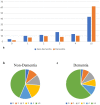The prevalence and co-existence of geriatric syndromes in older patients with dementia compared to those without dementia
- PMID: 38472505
- PMCID: PMC10933188
- DOI: 10.1007/s40520-024-02724-8
The prevalence and co-existence of geriatric syndromes in older patients with dementia compared to those without dementia
Abstract
Background: This study aims to compare frequency and coexistence of geriatric syndromes in older patients with dementia to those without dementia.
Methods: 1392 patients admitted to geriatric outpatient clinics were evaluated. Evaluations for eleven geriatric syndromes including polypharmacy, malnutrition, fraility, sarcopenia, dysphagia, urinary incontinence, fear of falling, falls, insomnia, excessive daytime sleepiness, and orthostatic hypotension (OH) were carried out in consultation with the patient and the caregiver. Two groups with and without dementia were matched according to age and gender using the propensity score matching method.
Results: A total of 738 patients, 369 with dementia and 369 without dementia were included, of whom 70.1% were female and the mean age was 80.5 ± 6.8. Polypharmacy, malnutrition, frailty, sarcopenia, dysphagia, fear of falling, and excessive daytime sleepiness were significantly higher in patients with dementia (p < 0.05). There was no difference between OH, urinary incontinence and insomnia between groups (p > 0.05). The co-existence of 0, 1, 2, 3, 4 and ≥ 5 geriatric syndromes in the same patient was 4.3%, 10.2%, 11.8%, 16.8%, 13.4% and 43.7% in non-dementia patients, respectively; 2.4%, 7.2%, 9.6%, 8.3%, 10.4% and 62.1% in those with dementia, respectively (p < 0.05).
Conclusion: The presence and co-existence of geriatric syndromes is common in patients with dementia. These geriatric syndromes should be examined by clinicians and healthcare professionals who work with the demented population, so that more successful management of dementia patients may be achieved.
Keywords: Dementia; Frailty; Geriatric syndromes; Malnutrition; Older adults; Polypharmacy.
© 2024. The Author(s).
Conflict of interest statement
The researchers claim no conflicts of interest.
Figures
Similar articles
-
Prevalence and co-incidence of geriatric syndromes according to glomerular filtration rate in older patients.Int Urol Nephrol. 2023 Feb;55(2):469-476. doi: 10.1007/s11255-022-03356-5. Epub 2022 Aug 27. Int Urol Nephrol. 2023. PMID: 36030356
-
Frequency and coincidence of geriatric syndromes according to age groups: single-center experience in Turkey between 2013 and 2017.Clin Interv Aging. 2018 Oct 4;13:1899-1905. doi: 10.2147/CIA.S180281. eCollection 2018. Clin Interv Aging. 2018. PMID: 30323576 Free PMC article.
-
The prevalence and co-incidence of geriatric syndromes in older patients with early-stage Alzheimer's disease and dementia with Lewy bodies.Aging Clin Exp Res. 2021 Sep;33(9):2599-2603. doi: 10.1007/s40520-020-01774-y. Epub 2021 Jan 28. Aging Clin Exp Res. 2021. PMID: 33506311
-
Role of Geriatric Syndromes in the Management of Atrial Fibrillation in Older Adults: A Narrative Review.J Am Med Dir Assoc. 2019 Feb;20(2):123-130. doi: 10.1016/j.jamda.2018.07.021. Epub 2018 Sep 27. J Am Med Dir Assoc. 2019. PMID: 30270028 Review.
-
Comorbidity in heart failure in the elderly.Clin Geriatr Med. 2000 Aug;16(3):631-48. doi: 10.1016/s0749-0690(05)70032-x. Clin Geriatr Med. 2000. PMID: 10918651 Review.
Cited by
-
Clinical implication of anemia in older patients with dementia with lewy bodies.Aging Clin Exp Res. 2025 Feb 18;37(1):39. doi: 10.1007/s40520-025-02958-0. Aging Clin Exp Res. 2025. PMID: 39964627 Free PMC article.
-
From Pain Control to Early Mobility: The Evolution of Regional Anesthesia in Geriatric Total Hip Arthroplasty.Reports (MDPI). 2025 May 9;8(2):64. doi: 10.3390/reports8020064. Reports (MDPI). 2025. PMID: 40710855 Free PMC article. Review.
-
The Fried Phenotype Is More Closely Associated With Dementia in Older Adults Than the FRAIL (Fatigue, Resistance, Ambulation, Illness, and Loss of Weight) Index.Cureus. 2025 Jul 16;17(7):e88094. doi: 10.7759/cureus.88094. eCollection 2025 Jul. Cureus. 2025. PMID: 40821233 Free PMC article.
-
Prevalence, Impact, and Screening Methods of Sarcopenia in Japanese Patients With Parkinson's Disease: A Prospective Cross-Sectional Study.Cureus. 2024 Jul 24;16(7):e65316. doi: 10.7759/cureus.65316. eCollection 2024 Jul. Cureus. 2024. PMID: 39184585 Free PMC article.
-
Prevalence of Geriatric Syndromes among Older Outpatients with Dementia.Dement Geriatr Cogn Dis Extra. 2024 Sep 2;14(1):89-95. doi: 10.1159/000541237. eCollection 2024 Jan-Dec. Dement Geriatr Cogn Dis Extra. 2024. PMID: 39473812 Free PMC article.
References
-
- Marie Curie Cancer Care (2021). Facts and figures. [cited 15 January 2022]. https://www.mariecurie.org.uk/globalassets/media/documents/media-centre/....
MeSH terms
LinkOut - more resources
Full Text Sources
Medical



